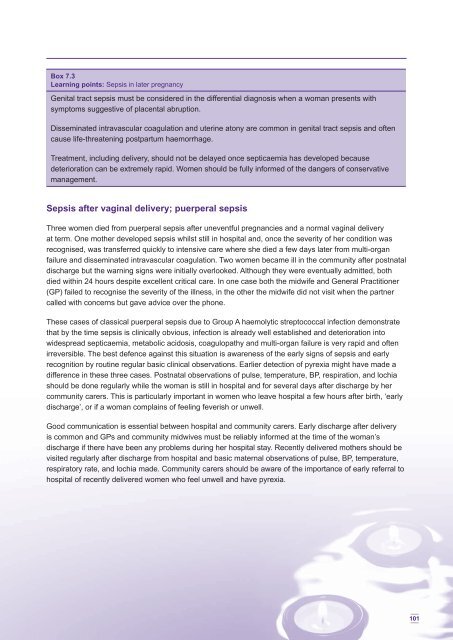Saving Mothers' Lives: - Public Health Agency for Northern Ireland
Saving Mothers' Lives: - Public Health Agency for Northern Ireland
Saving Mothers' Lives: - Public Health Agency for Northern Ireland
You also want an ePaper? Increase the reach of your titles
YUMPU automatically turns print PDFs into web optimized ePapers that Google loves.
Box 7.3<br />
Learning points: Sepsis in later pregnancy<br />
Genital tract sepsis must be considered in the differential diagnosis when a woman presents with<br />
symptoms suggestive of placental abruption.<br />
Disseminated intravascular coagulation and uterine atony are common in genital tract sepsis and often<br />
cause life-threatening postpartum haemorrhage.<br />
Treatment, including delivery, should not be delayed once septicaemia has developed because<br />
deterioration can be extremely rapid. Women should be fully in<strong>for</strong>med of the dangers of conservative<br />
management.<br />
Sepsis after vaginal delivery; puerperal sepsis<br />
Three women died from puerperal sepsis after uneventful pregnancies and a normal vaginal delivery<br />
at term. One mother developed sepsis whilst still in hospital and, once the severity of her condition was<br />
recognised, was transferred quickly to intensive care where she died a few days later from multi-organ<br />
failure and disseminated intravascular coagulation. Two women became ill in the community after postnatal<br />
discharge but the warning signs were initially overlooked. Although they were eventually admitted, both<br />
died within 24 hours despite excellent critical care. In one case both the midwife and General Practitioner<br />
(GP) failed to recognise the severity of the illness, in the other the midwife did not visit when the partner<br />
called with concerns but gave advice over the phone.<br />
These cases of classical puerperal sepsis due to Group A haemolytic streptococcal infection demonstrate<br />
that by the time sepsis is clinically obvious, infection is already well established and deterioration into<br />
widespread septicaemia, metabolic acidosis, coagulopathy and multi-organ failure is very rapid and often<br />
irreversible. The best defence against this situation is awareness of the early signs of sepsis and early<br />
recognition by routine regular basic clinical observations. Earlier detection of pyrexia might have made a<br />
difference in these three cases. Postnatal observations of pulse, temperature, BP, respiration, and lochia<br />
should be done regularly while the woman is still in hospital and <strong>for</strong> several days after discharge by her<br />
community carers. This is particularly important in women who leave hospital a few hours after birth, ‘early<br />
discharge’, or if a woman complains of feeling feverish or unwell.<br />
Good communication is essential between hospital and community carers. Early discharge after delivery<br />
is common and GPs and community midwives must be reliably in<strong>for</strong>med at the time of the woman’s<br />
discharge if there have been any problems during her hospital stay. Recently delivered mothers should be<br />
visited regularly after discharge from hospital and basic maternal observations of pulse, BP, temperature,<br />
respiratory rate, and lochia made. Community carers should be aware of the importance of early referral to<br />
hospital of recently delivered women who feel unwell and have pyrexia.<br />
101



